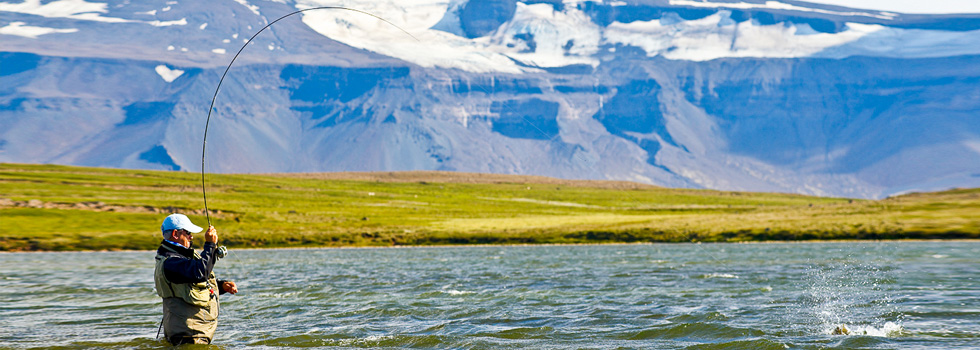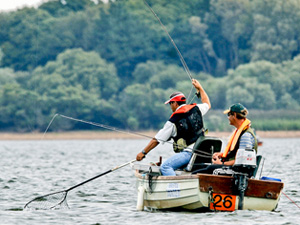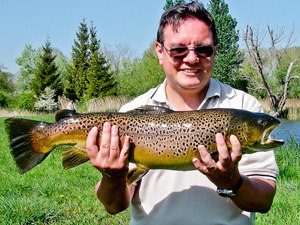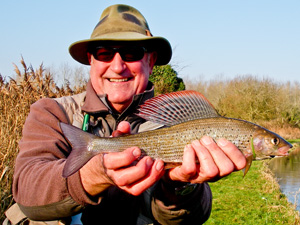
Trout Fishing
There are so many fantastic places to fly fish for trout around the World. From wading across volcanic lakes in Iceland (see picture above) in search of huge spotted wild Brown Trout, to battling with double figure Rainbows on tiny dry flies from the crystal clear rivers of New Zealand. The appeal is the same, just the location is different.
Chew Valley and Blagdon Lakes
 We are lucky to have some wonderful lakes, rivers and reservoirs here in the UK and the quality of the trout can be superb. I am very lucky to live just a few minutes from both Chew Valley and Blagdon Lakes. These are wonderful venues, set amidst the beauty of the rolling Mendip Hills.
We are lucky to have some wonderful lakes, rivers and reservoirs here in the UK and the quality of the trout can be superb. I am very lucky to live just a few minutes from both Chew Valley and Blagdon Lakes. These are wonderful venues, set amidst the beauty of the rolling Mendip Hills.
Although quality Rainbow Trout are the main species, both lakes have big numbers of Brown Trout present – some as big as 22lbs have been caught in recent years. The Bristol Water Trout are reared in their own hatchery at Ubley and the Brown Trout are a cross between Loch Leven and local River Yeo brownies.
I am often on the water 7 days a week with clients and this means being in constant touch with the changing weather conditions and the corresponding change in the trouts’ behaviour.
Thanks to a very fertile aquatic environment, the supply of natural food means Chew Valley and Blagdon trout have plenty of choice in their diet. For this reason, we have to constantly alter our tactics to have the best chance of success.
Staying Dry
 Dry Fly is my favourite fly fishing technique and both lakes have phenomenal hatches, making it ideal for this incredibly visual method. We no longer use a single dry, but fish teams of three to enhance our chances of success.
Dry Fly is my favourite fly fishing technique and both lakes have phenomenal hatches, making it ideal for this incredibly visual method. We no longer use a single dry, but fish teams of three to enhance our chances of success.
Nymph'omania
Nymphing comes to the fore when the fish are not rising. The massive numbers of midge pupae present means techniques such as “Static Nymph”, “Washing Line” and “Straight Line Nymphing” are principle methods throughout the season.
That sinking feeling
Sinking Line methods are an area of huge mystique. We all love to fish a floater, but sometimes the conditions dictate that we have to resort to sinking line tactics. Believe me, successful sinking line techniques are a great way to fish and not simply a case of “chuck it out and strip it back”!
The Lure of success
Lures are another important part of the fly fisher’s armoury and can be highly imitative. Trout that are feeding on small fish, damsel nymphs and other larger items will often ignore nymph patterns in preference for a bigger mouthful. There is more subtlety to lure fishing than many anglers realise.
Other Venues
My competition fishing takes me to lakes and rivers all over the UK. As a result, I am happy to guide at other waters such as Rutland, Grafham, Bewl, Eyebrook, Draycote and Llyn Brenig. In fact, if you want to fish it - I'll take you there!
River Fishing for Trout and Grayling
 I frequently fish rivers such as the River Test, River Dee in North Wales, River Tweed in Scotland and River Mourne in Northern Ireland.
I frequently fish rivers such as the River Test, River Dee in North Wales, River Tweed in Scotland and River Mourne in Northern Ireland.
Casting a dry fly to a sipping trout, watching it rise to your perfectly presented fly, then striking to set the hook before all hell is let loose as it takes off at a rate of knots downstream; is probably the ultimate river experience and I love it!
However, when the days shorten and the temperature drops, the fly hatches stop and the fish turn to nymph feeding instead. The Winter months now provide the perfect opportunity to target Grayling in the River Test and other chalkstreams in the South of England. I have access to several beats which remain open during the normal close season, allowing guests to fish for the "Lady of the Stream".
Thanks to fishing against the top Polish, Czech and French river anglers, I have gleaned loads of information on how to fish methods such as Czech Nymphing and Micro Nymphing where the use of long, French style leaders is employed.
